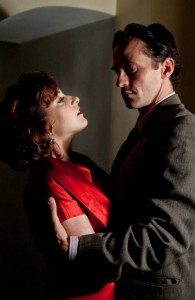
The shadowy lit office of the private detective, the distressed dame, the missing person. To successfully lampoon a genre, you first have to faithfully reproduce it in as recognizable of terms as possible. Stolen Chair's Kill Me Like You Mean It, the "theatrical noir" at Fourth Street Theater, does this with ease, bringing enough intrigue and atmosphere to the East Village to rattle Humphrey Bogart. In doing so, Kill Me is then free to do as it pleases, cracking the film noir open and sucking the audience in, heightening the stylized, dreamlike elements of the genre to absurdist proportions.
Playwright Kiran Rikhye's comical mystery hangs on a deliciously literary minded plot. Hardened Private Eye Ben Farrell, played with a straight-faced cool by Nathan Darrow, stumbles headfirst into a case that hits frighteningly close to home. Tommy Dickey, "Murder Monthly's" most popular crime writer, has been writing a serialized tale about a detective named Bob Darrell, and each time a new installment is published, Farrell gets called on to investigate a crime that unfolds exactly as the story. Now Dickey wants to kill off Darrell, and taking the case means Farrell must face his own mortality... and attempt to stall fate.
Could Dickey, a wealthy dilettante played with a devilish, John Waters finesse by David Skeist, be in cahoots with Lydia Forsythe (played with doe-eyed mischievousness by Natalie Hegg), the driven publisher who will stop at nothing to shock and appeal to the "average American reader"? Will Dickey's beautiful, widowed, bejeweled sister Vivian Ballantine help Darrell solve the mystery or cause his ruin? As Farrell encounters each new character and each new suspect, the play spins into an absurdist exercise in verbal sparring and physical comedy, pushing the expectations of the show to hilarious extremes. In one scene, Farrell and his old cop buddy jockey for position on two desk chairs during a heated confrontation that comes off like a scene from Flashdance. Similarly, the slapstick relies on endless repetition; a cigarette accepted as the old one behind the ear is tossed to the ground, or three whiskey tumblers filled and set down one after another, untouched.
 If you can hold on to the fast-talking doublespeak of the genre in which so many words come out but so little is actually said, the play reveals its genius: how quickly excess can become absurd and how hilarious excess can be, and also how human nature ultimately reveals itself through paradox. Ballantine, played with a slinky deadpan by Sarah Skeist, muses, "You oversimplify everything, it makes things so complicated." Or later, "it's always such a happy coincidence when the things one believes turn out to be true."
If you can hold on to the fast-talking doublespeak of the genre in which so many words come out but so little is actually said, the play reveals its genius: how quickly excess can become absurd and how hilarious excess can be, and also how human nature ultimately reveals itself through paradox. Ballantine, played with a slinky deadpan by Sarah Skeist, muses, "You oversimplify everything, it makes things so complicated." Or later, "it's always such a happy coincidence when the things one believes turn out to be true."
Film noir requires snapshots, dramatic flashes from scene to scene, which is the one thing its cousin theatre noir can't provide, through no fault of the techies (fedora clad detectives, of course), and transitions between scenes sometimes lagged or deflated suspenseful momentum. This issue was more than compensated for, however, by a shifting lighting design by David Bengali, making it quickly apparent why the company suggests that, should you return, which you'll be tempted to do, you should see the production from another seat. Not one for doing things half-heartedly, my partner and I took the plunge, sitting in "directors seat rows 1 and 2," the most centrally located seats on the precarious wooden riser planted stage left, which we mounted after swiftly consuming the complimentary glass of whiskey. Sitting up there meant creaking during every foot shift and some blocking faux pas, but it also meant sharp lighting angles and framed shots that were remarkably ephemeral, spontaneous, and personal: two lovers so close you could graze them with your boots; a character, caught in a chokehold so intimately framed above the aggressor's shoulder Hitchcock could only dream of it.
One flip of the remote and film noir is accessible to watch on television. But it's far less common to get to live it, to slither downstairs into a darkly lit theater, sip a glass of whiskey poured by a curly haired usherette, listen to a fedora clad crooner sing 1940s hits beneath the buzzing neon of Ben Farrell's detective agency, and wait, with baited breath, to find out whodunnit.